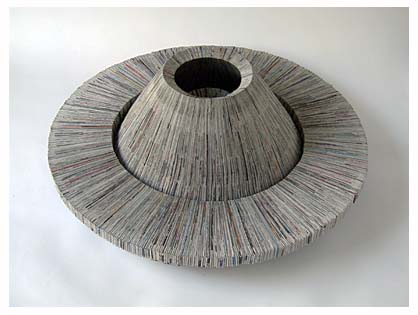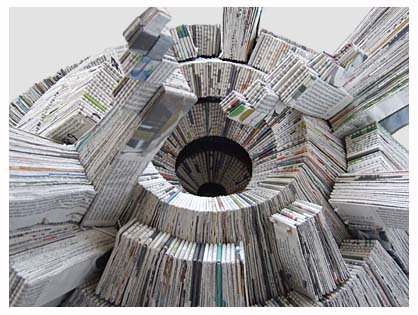 Pupils astonish public as Recycling exhibition takes centre stage
Pupils astonish public as Recycling exhibition takes centre stage |
Maiden Erlegh Pupils have, yet again, reigned supreme in their current exhibition held at the Peacock Gallery.
The year 9 students who have taken Art as one of their 4 chosen options have created an inspiring display of their 3-D and 2-D artwork. They were given the recurring theme of recycling as the base point of each individual piece that contributed to the finished product. This meant that their imaginations could go wild with the different media usage and whether to create 2-D or 3-D pieces.
The Medias, which were all recycled in some way, were; cardboard, wire, packets of crisps, tea bags, old curtains/material, egg cartons, sweet rappers, melted crayons, books, newspapers-the list is endless. But the brilliant thing about these pieces is that they are all completely recycled- not using ready made materials but looking around us and appreciating how much material we would normally throw away with out thinking and how we can turn that into a piece of art.
I have visited the exhibition and all of the pieces were eye catching and brilliant- although- there were a few pieces which because of their simplicity or intricacy really caught my eye.
My first favourite picture was by a fellow pupil called Hannah Ng:
 |
I particularly liked this piece because it had encapsulated the meaning and idea of recycling and creating new things from the old. The artist has made four origami cranes and has made them, cleverly, seem like they are flying away from the book-maybe meaning that they are breaking free from the book into the world-showing how the world wants to break free and care about it more.
I think the main reason why I enjoy this piece is the contrast in colours between the solemn monotone book paper and the bright, blue, abstract collage in the background. She has smartly used different shades of blue onto the shoe box which makes the conceptual square and corner-like background. This makes a real difference to the duller tones of the book which is really what makes the piece so interesting to look at.
I also like how she has used the shoe box to hover over the piece- and make it enclosed so there is a definite ending to the piece outwards-but- there is not definite ending to the piece as it comes out to you; so you can see every nook and cranny of it. An overall great effort- and one of my favourite pieces.
The next eye catching piece was called ‘My Bionic Bird’ by Isaac Robinson,
The colours have worked particularly effectively because the red and green and the hint of black all merge together from the wires to create a lovely silhouette when light is shone through it. I think that this has successfully reached the brief of being recycled; as it has that reused feel. It was displayed by being hung from the ceiling with clear string which gave the illusion of the bird really flying; adding to the execution of the final piece and the realistic components of it.
The last piece that really stood out in the gallery was by Tom Ryan;
He has made this by creating the hands out of rolled up newspaper and stiffening it with glue. He has then modelled the hands to the suitable position of someone drawing-which adds to it as it is in an art lesson. After he had completed the hands he used a book which I believe was from Oxfam books where they were going to throw away it and then stuck them together at a slight angle.
He added extra details and frills by adding in the ripped pages from where the hand has burst out of the book and into reality. I also liked how he added the simple touch of putting a pencil into the hands to add a small jolt of colour. This is clever because it lets your eyes focus on different things in the piece- and not get bored. Adding all of these supplements creates the piece to be more and more realistic. So realistic that I feel like I could actually touch the hand and it would respond and start moving.
The simplicity of using just recycled paper really made the colours and the overall sculpture much more interesting because you would have newspapers with stories that you could spot, colours from advertisements brightening the piece and the black and white text and background giving it a solid colour scheme.
This topic of recycling has taught the year 9’s so many techniques of 3-D art that can be used much more. But it has also taught us that we really can create something from nothing-or in this case-rubbish. We have also learnt and discovered how many artists have created such amazing ideas and projects all from recycling and reusing.
Recycling really is a good idea, especially when you are creating art, because unless you try, you can never find out how many materials that could be made into something amazing are being thrown away every day and how you can easily create them into something new.
With all of the news surrounded with claims of global warming and cutting down of the rainforests making a few pieces of paper into a sculpture or collage makes use of what we would usually waste. I think all year 9 students should be proud of the work they’ve done-after all, at the age of 13/14 you have already had a piece of artwork in a gallery!
So, why don’t you give it a go?
The art exhibition overall was a complete success and it is open until the 16th of Decemeber. You wouldn’t want to miss it. Get inspired!

























 This is page 202 of the Humument
This is page 202 of the Humument

 ' Artists at work'
' Artists at work'

